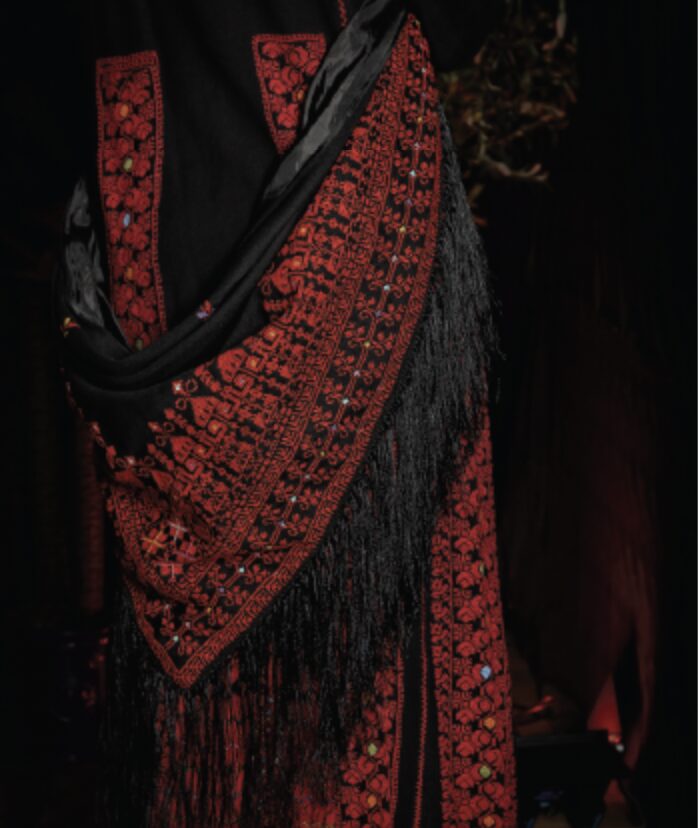Archiving Palestine
How Palestinian women use embroidery to resist
Sarah Samuel

Photo courtesy Rana Abdulla
Razan Samara is a longtime Palestinian activist. She’s volunteered with the Toronto chapter of the Palestinian Youth Movement. She’s made banners and fundraised for Palestinians in the homelands. But in 2021, when Palestinians were expelled from their homes in Silwan and Sheikh Jarrah, she began to feel that she needed to do more for her community. As a way to cope with the expulsion of her people and reconnect with her ancestral land, Samara started holding tatreez, or embroidery, circles with her mom.
Their circles are held at a cafe in Mississauga and include 15 to 20 people, usually from Palestinian and Arab diaspora, as well as a few urban Indigenous people. Sometimes people bring their relatives, but often they are alone, sitting next to a stranger with the knowledge that they, too, have been displaced from their homeland.
“So suddenly we’re back to our villages,” Samara says. She opens each tatreez circle by tossing a thread ball while everyone in the circle names the places they hail from. As they do so, they hold onto a section of the thread and then toss the ball to the next person, which forms a web. By tossing the ball and speaking their truth, grief, and hopes, the thread connects everyone both physically and emotionally.
Samara says tatreez has always been a part of her household as an aesthetic article. But it was more recently that she learned about its historical significance. “The tatreez patterns are so rooted in the landscape and architecture of Palestine; and having been displaced from that, it was a way of being one with [the land].”
The 3,000-year-old art form and its current resurgence represents Palestinian women’s defiance of their oppressors. Palestinian women weaved tatreez to archive the story of Palestine through displacement dating back to the 1948 Nakba (the catastrophe) and 1967 Naksa (the setback), times when Israel forcibly took over Palestinian territories and expelled over 750,000 Palestinians from their lands. The tatreez thobes, or dresses, following that era, notably after the First Intifada, a six-year Palestinian uprising from 1987 to 1993, depict Palestinian flags, the Qubbat aṣ–Ṣaḵra (Dome of the Rock), doves, rifles, and other motifs. Embroidery artists also hide secrets in tiny stitches depicting trees and birds, at times appearing in clusters of fives and sevens to ward off the evil eye.
Palestinian embroiderers in the diaspora in Canada, in refugee camps in Lebanon, and under Israeli military occupation in Palestine are constantly adding to their motifs. The triangle, the cypress tree, and the kite are now common alongside the watermelon slice and the fishnet pattern.
Rana Abdulla, founder of the Canadian Palestinian Association of Manitoba, collects vintage tatreez dresses. Earlier this year, her collection was displayed at the Canadian Museum for Human Rights to commemorate the Palestinian lives lost during ongoing Israeli atrocities in Gaza. As of publication, that number stands at over 43,391. Abdulla says tatreez is nuanced, as it preserves the story of the artist. “It is a form of resistance and the story of each dress is a story of each woman. The colours of the embroidery express the national allegiance as Palestinians and are attributable to each village in Palestine,” she says. In Tulkarm, the town her family is from, the tatreez is rich with pomegranates and leaves embroidered on white fabric.
Tatreez, Samara says, is a living document that archives what the Palestinian people have endured and continue to withstand in their anticipation of a liberated Palestine.
“We’re sitting together and having very open and candid conversations about the occupation and exile. As we tatreez together, we are connecting with it as a practice, creating a pathway back and thinking about the future—in a liberated Palestine where we would invite our friends and allies to our houses for tea.”
With rampant censorship on the expression of Palestinian identity in North America, Samara said that there’s a sense of pride attached to wearing a Palestinian tatreez thobe in a very explicit way. “Every single stitch is in defiance to whatever false narratives that may exist.”